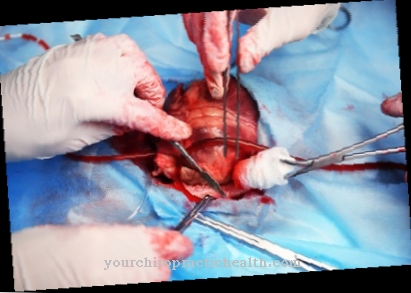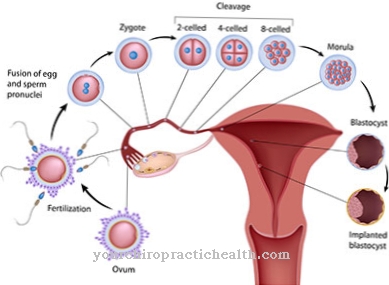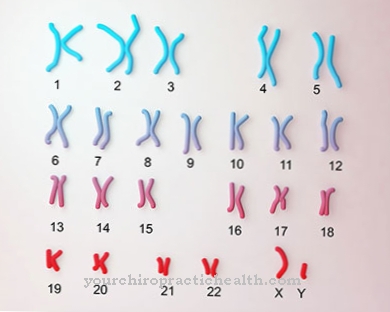At a Microtia it is a congenital malformation of the auricle. The outer ear is not completely formed. Sometimes the ear canal is very small or missing completely. Reconstruction of the ear and surgery to improve hearing are possible treatments.
What is microtia?

© rufar - stock.adobe.com
The malformation of the outer ear is congenital. The incomplete development of the ear can lead to minor malformations or the ear canal completely missing. The term is derived Microtia by the translation "small ear". A cartilage plate completely separates the outer ear from the inner ear, which subsequently leads to a significant reduction in hearing.
Microtia can occur either on one side of the head or on both sides. In many cases, an underdevelopment of the lower jaw occurs simultaneously with microtia. microtia is one of the largest forms of congenital ear defects. Microtia is divided into four stages:
- Grade 1 describes a minimal malformation in which most of the ear has normal anatomy.
- Grade 2 shows an optically normal auricle formation, especially in the lower part. However, the ear canal can be different, smaller or completely closed.
- In Grade 3, the ear is shaped like a peanut and has no ear canal.
- In grade 4, the outer ear and ear canal are completely absent.
causes
The causes of microtia are probably not entirely clear.Both genetic factors and environmental influences could play a role in this congenital malformation. However, genetics are only likely to be responsible for five percent of patients. Vascular disorders that have occurred in the development of the fetus are also possible, but this has not been clearly proven.
Possible causes of microtia are probably related to the consumption of coffee, alcohol or substance abuse during pregnancy - especially in the first trimester of pregnancy. Medicines could also be a possible trigger for this malformation. The frequency of occurrence of microtia is found more frequently among certain peoples such as Asians or residents of the Andes. The probability that a child will be born with microtia is 1 in 6,000 or 12,000 births.
Symptoms, ailments & signs
The microtia is found in ten percent of those affected on both sides, the so-called bilateral microtia. The frequency of this congenital anomaly is mostly found more often on the right side of the head and mostly forms only on one side. The main complaints are hearing loss, as there is no normal ear canal as well as eardrum and ossicles. Those affected with microtia can still hear a few tones, but not through the ear canal. In microtia, the auricle is missing, and sometimes an ear lobe with a remnant of the auricle is present.
Diagnosis & course of disease
Human genetics should be consulted to clarify if microtia occurs more often in the family. Early clarification by specialists such as ENT doctors, paediatricians as well as phoniatrists and pediatric audiologists is recommended. Possible negative influences during early pregnancy should be clarified.
From the age of 10, computed tomography can provide more accurate information about the middle ear structures. A diagnosis of the malformation is recommended at an early age. Suitable methods for clarification are regular hearing tests and computed tomography to detect middle ear defects.
Complications
The microtia primarily causes hearing problems in patients. The incorrect design of the auricle can lead to impaired hearing or to complete deafness. However, this complaint does not reduce or limit the patient's life expectancy. Especially young people or small children can develop severe psychological complaints or depression due to microtia.
Those affected can only hear certain tones and suffer from significant restrictions in their everyday life. In children, microtia can also lead to disorders of development, so that this is slowed down and consequential damage occurs in adulthood. In some cases, microtia can also lead to imbalance.
The symptoms of the disease can be limited and resolved relatively well with the help of implants and hearing aids. There are no particular complications or complaints. However, parents need to strengthen their children's self-esteem to avoid inferiority complexes. Surgical intervention can further reduce hearing problems. Here, too, there are no particular complications.
When should you go to the doctor?
Serious microtia is usually diagnosed immediately after birth or in the first few months of the baby's life. Basically, this malformation of the ear is not dangerous, unless it is part of a syndrome. In the majority of cases this is not the case. Nevertheless, it would be advisable to visit the pediatrician or a specialist. Depending on the severity and shape of the microtia, this can significantly reduce the child's hearing. If left untreated, this can result in language deficits and consequential damage in adulthood. For this reason, it is advisable to have a hearing test carried out by an ENT doctor as early as possible. A doctor should be consulted if there are also problems with balance.
Surgical correction of the microtia and the insertion of a bone conduction hearing aid can only be carried out from the age of four or five at the earliest, as these interventions require a certain degree of physical maturity. However, if there is only a mild form of microtia and the child is not restricted by it, no medical treatment is required. In some cases, due to microtia, especially in childhood and adolescence, those affected can develop psychological complaints such as inferiority complexes or depression. Here it is advisable to seek therapeutic help.
Therapy & Treatment
Treatment by pediatric audiologists and ENT specialists is helpful because of the hearing impairment associated with microtia. The existing hearing loss must be continuously clarified and treated accordingly. With a so-called otoplasty, the missing auricle can be reproduced from the body's own tissue. The normal hearing ear also needs consistent control. If conductive or sensory hearing loss occurs, action is required.
If there is a bilateral malformation caused by microtia, the child can be provided with a bone conduction hearing aid. An operation to correct the malformation should be done at the earliest between four and five years of age in order to have the necessary physical maturity for this procedure. Alternatively, an implant can be used in the case of microtia in order to avoid the invasive procedure with surgery. Since the microtia is not as clearly visible as defects in the face, the psychological burden is not necessarily great.
However, a reconstruction of the ear improves the quality of life of those affected and also improves self-esteem. In addition, the reduction of the congenital deficit of microtia is associated with an increase in security in the social environment. Since the hearing ability is almost always limited with microtia, an operation in ENT surgery to improve hearing is usually necessary or recommended.
Before the ear is rebuilt, an operation on the middle ear should be performed, since if the procedure is reversed, possible scars could hinder the ear construction. The operation takes place in several sub-steps. After about a year, the feeling in the newly built auricle returns in those affected. The hearing gain after an operation to improve hearing is between 20 and 40 decibels.
You can find your medication here
➔ Medicines for earache and inflammationOutlook & forecast
As a congenital malformation, microtia has no prospect of spontaneous healing or improvement. However, the prognosis for a possible improvement in the auricular malformation is usually very good. Several factors are relevant for the exact prognosis - for example, whether both ears are affected and the inner and middle ear are completely intact. If, for example, only the auricles are malformed, small-scale operations from the field of plastic surgery can at least improve hearing enormously. Further adaptation and reconstruction of an ordinary ear is often possible.
Possible developmental disorders that occur as a result of impaired hearing, however, harbor the risk of greater limitations. These should be addressed early for the best prospect of compensation. It should also be noted that the perceived quality of life for those affected is greatly improved by acting quickly. In many cases, impaired hearing is not the only burden for those affected, but also dissatisfaction with one's own face and head due to the deformation.
If microtia also occurs more frequently in families, a genetic component can be assumed. This can be investigated when in doubt. Findings about this are relevant with regard to further family planning and a certainty that has taken place. There is currently no real prevention of auricular malformation in prospect, but a certainty about the risk for your own child can be very helpful.
prevention
To prevent microtia, especially in the first trimester of pregnancy, particular care should be taken to ensure that pregnant women do not consume alcoholic beverages, smoke or consume drugs. The use of medication should possibly also be clarified with the attending physician in order to rule out any risk.
Aftercare
Existing hearing loss can lead to various complaints and complications in those affected, which may require continued follow-up care. Although these complaints do not reduce life expectancy, they can have a very negative effect on the patient's quality of life and lead to significant restrictions in everyday life. Therefore, an examination by a doctor should take place at the first signs and symptoms.
Those affected are sometimes tense due to their hearing impairment and not infrequently suffer from mental disorders. Sensitive conversations with friends and family help to alleviate mental suffering. It is also useful to make the social environment aware of the existing illness in order to prevent prejudice or misunderstandings.
Sometimes this can lead to inferiority complexes or a reduced self-esteem in those affected if this illness persists and restricts the everyday life of the person concerned. Especially in stressful situations, the symptoms can worsen so that the person affected can no longer concentrate properly. Therefore, addressing people in a targeted manner is an essential element of aftercare in order to be able to cope with the disease on a permanent basis.
You can do that yourself
Those affected generally not only suffer from hearing loss, but also from the aesthetic impairment associated with the missing or incompletely formed auricle.
In families in which a malformation of the auricle is common, a hearing test should already be carried out on very young children in order to detect any disturbances early on. Undetected hearing damage can lead to a delay in development, which in severe cases affects those affected even as adults. Hearing deficits can usually first be compensated for with hearing aids. Later on, it is usually possible to correct the impairment through an operation on the middle ear. A plastic-surgical reconstruction of the auricle is only recommended afterwards.
However, surgical interventions on the ear are usually not carried out in childhood. Children who suffer from microtia, which is accompanied by a clearly visible malformation of the outer ear, are therefore often teased in kindergarten and primary school. Parents should pay attention to whether their child is suffering from the psychological problem and take countermeasures in good time. Often even simple means help, for example a hairstyle that covers the ears so that the malformation is not constantly visible in everyday life. A child psychologist should be consulted if children are severely mentally affected by the aesthetic impairment.


.jpg)
.jpg)









.jpg)

.jpg)
.jpg)











.jpg)